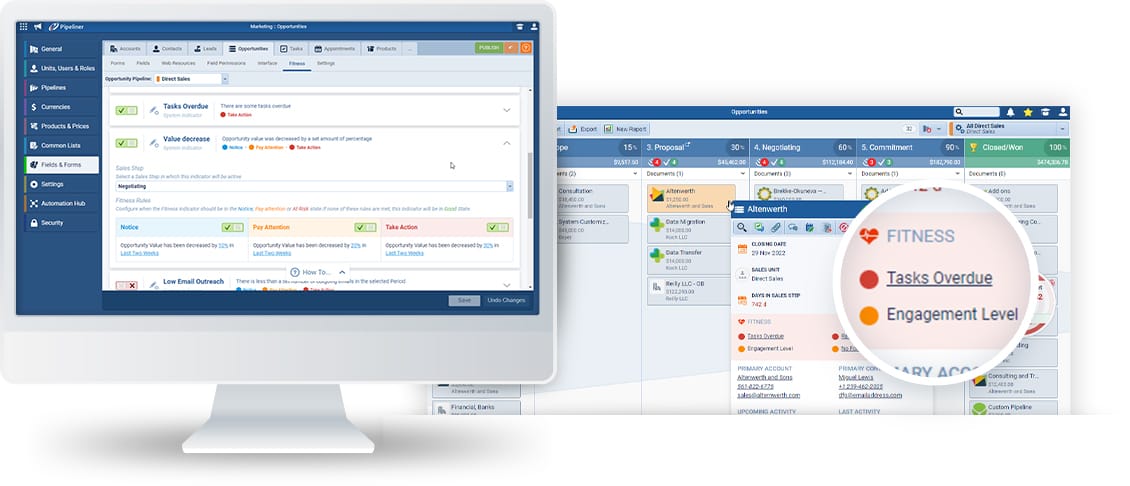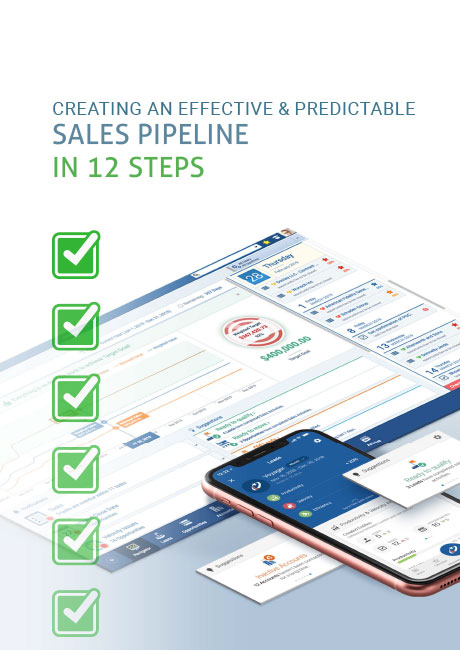Opportunity Management
What is CRM
- What is CRM?
- Customer Relationship Management Software
- Account Management Software
- Contact Management Software
- Sales Lead Management
- Opportunity Management
- Sales Pipeline Management
- Customer Relationship Mapping
- Sales Enablement Tools
- Sales Management Software
- Sales Process
- Sales Reporting
- Task Management
- Custom Fields
- Team Collaboration
- KPIs for Sales & Leading and Lagging Indicators
- CRM Past Failures?
Sales Opportunity Management Software
Sales Opportunity Management software is essential for success in business.
What Is A Sales Opportunity?
A qualified contact or accountAccount Account refers to a record of primary and background information about an individual or corporate customer, including contact data, preferred services, and transactions with your company. is referred to as a sales opportunity. A leadLead Lead refers to a prospect or potential customer (who can be an individual or organization) that exhibits interest in your service or product; or any additional information about such entity. is on its way to becoming an opportunity when it enters your sales funnelSales Funnel Sales Funnel is a visualization of the sales process that defines the stages through which prospective customers go through as they are led by sales professionals towards a purchasing decision. and expresses a need for your services. You must then initiate contact with the lead and conduct research on their budget, timeline, purchasing authority, and so on.
Leads become opportunities. Leads are individuals who have expressed an interest in your productProduct Product refers to anything (an idea, item, service, process or information) that meets a need or a desire and is offered to a market, usually but not always at a price. or service via various channels, such as downloading promotional materials or receiving a sales call.
Your “opportunity” is the critical stage between identifying a lead and closing or losing a deal. You get to introduce your product and persuade your prospect to buy it. Your sales team has most likely expended significant effort in interacting with the right people, involving stakeholders, making presentations, and showcasing demos to assist them in making that purchasing decision.
What Is A Sales Opportunity Management Software?
Sales opportunity management is a process that aids in the management and monitoring of sales opportunities as they progress through the pipelinePipeline Sales pipelineis a visual representation of the stage prospects are in the sales process.. By effectively managing opportunities, you can significantly increase the chances of conversionConversion Conversion is the process of turning a target consumer into a paying customer; or more generally, the point at which a user performs a specific action favorable to a marketer or a seller. and generate more profit.
By establishing a clear process for sales representatives to follow, opportunity management enables you to close more sales.
It is a comprehensive strategy that takes into account your organizationOrganization Organization is a cohesive group of people working together and formally bound by a shared identity (e.g., one team, company, club, etc.) and a common purpose (e.g., business growth, athletic victory, etc.).’s overall success and growth. Opportunity management can boost your sales team’s productivity and performance by serving as a roadmap for optimizing the sales processSales Process Sales Process is a series of strategic steps or a set of activities aimed at driving sales growth through the alignment of personnel, market insight, methodologies, relevant business units, and technology. and its steps.
The process also highlights potential risks and opportunities in your sales pipeline. Access to such critical information enables your sales team to take timely action and provide services tailored to prospects’ needs.
Why Does It Matter For Businesses?
Sales opportunity management is important because it allows you to sell more efficiently. Effective sales opportunity management allows you to gain a better understanding of your customers, allowing you to prioritize your dealings with them based on their potential. You can assess risk factors and save time on lost deals. You can use opportunity management to:
- Understand potential buyers and their specific needs.
- Discover potential risks early in the sales pipelineSales Pipeline Sales Pipeline is a type of visualization showing the status of each sales prospect in the customer life cycle or sales process..
- Keep an eye on the deal’s progress.
- Create effective business proposals and close deals with legally binding contracts.
Main Categories of Sales Opportunities
Sales opportunities come in various forms and sizes, and not all are created equal. Knowing which type of opportunity you’re dealing with can help your team tailor their approach and boost your odds of sealing the deal. Here are the five primary categories you’ll encounter:
- Net New BusinessNet New Business Net New Business is a prospect that you have newly converted into a paying customer or an existing account that has been dormant for a long period but has been re-engaged and reactivated as a revenue-generating account.: These are fresh prospects—potential clients or companies that haven’t worked with you before. Think of this as breaking new ground and introducing everything you have to offer to someone for the very first time.
- Cross-Sell: This involves introducing your existing customers to additional products or services that complement what they’ve already purchased. For example, a customerCustomer Customer is an individual or an organization that purchases a product or signs up for a service offered by a business. who has purchased your software may also benefit from your premium support package.
- Up-Sell: Here, you’re encouraging customers to upgrade—perhaps by moving from a basic version to a premium one, or adding more features to what they already use. It’s like suggesting the deluxe option at the car wash.
- Migration: Often seen in the technology and SaaSSaaS SaaS is an acronym for Software as a Service. industries, migration involves moving a customer from a competitor’s platform to yours or upgrading them to your latest offering. This can involve a bit more hand-holding but is highly rewarding when successful.
- Renewal: Finally, renewals are about retaining existing clients by encouraging them to continue their subscription or contract. These relationships are valuable, and maintaining them means less time spent hunting down new leads.
Mastering these opportunity types can transform a decent pipeline into a thriving one, enabling your sales team to prioritize efforts and address each prospect’s specific needs.
Why Should You Regularly Evaluate Your Opportunity Management Process?
Regularly reviewing your opportunity management process is essential for maintaining a high-performing sales operation. Just as athletes review their game footage to hone their strategy, your sales team should periodically analyze their opportunity management methods to spot areas for improvement and maximize results.
By evaluating how you identify, qualify, and progress opportunities in your pipeline, you can:
- Pinpoint strengths and weaknesses at each stage of the sales cycleSales Cycle Sales Cycle is a repeating process characterized by a predictable sequence of stages that a company undergoes as it sells its products and services to customers..
- Monitor key metricsMetrics Metrics are quantities that are measured and used to:, such as your win-loss ratio, average deal value, and conversion rates.
- Identify patterns that reveal which sources or activities generate the most profitable opportunities.
Routine assessments help you answer crucial questions: Are your follow-ups timely and effective? Is the sales cycle length aligned with your goals? Are your prospects satisfied with their buying experience?
Armed with this knowledge, your team can make informed adjustments—whether refining qualification criteria, reallocating resources, or personalizing communications—to continually improve your process and boost conversions. In short, evaluating your opportunity management process a regular habit ensures your business stays competitive, agile, and ready to close more deals.
Experience Pipeliner CRM Now
What Are Leads And Opportunities?
A lead is a sales prospectSales Prospect Sales Prospect is a potential consumer of your product or service who meets a given set of benchmarks; typically a sales lead whose financial capacity, buying authority and willingness to purchase are found sufficient enough to qualify and be upgraded in the sales funnel as a prospect., whereas an opportunity is a potential deal with a qualified prospect who has a high likelihood of becoming a customer. A sales opportunity should address a pain point that is relevant to the product or service being sold. A lead, on the other hand, is someone generally interested in your product or service.
How Should You Organize and Segment Sales Leads?
Effective lead organization is at the heart of a streamlined sales process. To maximize every opportunity, segment your leads in a way that enables your team to prioritize, personalize quickly, and progress opportunities through your pipeline. Here’s how to approach it:
- Segment by Key Criteria
Classify leads based on factors that directly influence your sales strategy, such as:
- Industry or sector
- Geographic region
- Level of engagementEngagement Engagement is the state or process of keeping a specific class of audience (employees, management, customers, etc.) interested about a company or brand and invested in its success because of its perceived relevance and benefits to the audience. or interest
Doing this enables sales representatives to immediately identify and focus on the highest-potential segments, tailoring their outreach accordingly.
- Qualify Based on Deal Potential
Not all leads are created equal. Assess and rate each lead on attributes like:
- Estimated revenueRevenue Revenue is the amount of money a business generates during a specific period such as a year or a quarter; also called sales. potential
- Fit with your ideal customer profile
- Past interactions and responsiveness
With these insights, your team can allocate time and resources more effectively to leads that are most likely to convert.
- Centralize and Standardize Information
Keep all relevant details—contact information, communication history, qualification notes—in one centralized system such as your CRM. This makes it easier to:
- Filter and sort leads on demand
- Share updates across your team for optimal collaboration
- Track where each lead sits within your sales funnel
- Identify Coaching and Training Needs
As patterns emerge, you’ll uncover areas for sales coachingSales Coaching Sales Coaching is the process of helping sales professionals improve their performance, efficiency, and impact largely through behavioral changes and the development of new skills. or skill-building—be it objectionObjection Objection refers to a position, statement or view of a prospect which indicates reservation about or disagreement with a particular aspect or the entirety of your sales pitch, lessening the likelihood of a purchase. handling, demo delivery, or tailored follow-ups. Continuous improvement means stronger, more effective engagement with your leads.
By organizing and segmenting your sales leads thoughtfully, you ensure nothing falls through the cracks and your team can operate with laser focus. This strategic approach lets you maximize every sales interaction and, ultimately, close more deals.
There are some benefits to using opportunity management in your business:
- Optimize your opportunity pipeline workflow: By standardizing your sales process, you can keep your opportunities moving forward.
- Increase your win ratio by understanding what you need to do next in each step and applying proper sales techniques.
- Enhance your understanding of your opportunities: It will become much easier to identify the most critical opportunities.
What Sources Can You Use to Identify New Sales Opportunities?
Sales opportunities don’t just appear out of thin air—they’re often hiding in plain sight if you know where to look. Consider tapping into the following sources to keep your pipeline full:
- Insights garnered from customer feedback and satisfaction surveys.
- Careful research into each clientClient A client is an entity who pays another entity for products purchased or services rendered. Also called a customer.’s specific needs and pain points.
- Social media listening for trends and direct mentions of challenges your product solves.
- Engaging with peers and prospects at industry conferences or networking events.
- Analyzing dataData Data is a set of quantitative and qualitative facts that can be used as reference or inputs for computations, analyses, descriptions, predictions, reasoning and planning. from your CRM and generating reports to spot promising patterns or prospects.
By leveraging these channels, you’ll stay ahead of changing customer expectations and ensure your team has a steady stream of opportunities to pursue.
The Value of Timely Responses to Leads and Prospects
Responding to leads and prospects quickly is one of the most critical factors in driving success throughout your sales process. Studies show that when a company follows up with a web lead within five minutes, the chances of engaging with that lead soar dramatically—far outpacing delayed replies. In those crucial early moments, your speed signals attentiveness and professionalism, immediately elevating your credibility.
Prospects have choices. Delayed responses can easily prompt them to search for solutions elsewhere. By making the effort to promptly answer questions, schedule appointments, or offer a timely product demo, you show that you value their time and needs.
Best practices suggest that every opportunity in your pipeline should always have a clearly defined next step—whether that’s a follow-up call, an email, or a tailored presentation. Not only does this keep momentum alive, but it also ensures opportunities don’t slip through the cracks.
Additionally, carefully logging each step and interaction in your CRM helps everyone on your sales team maintain a unified approach, preventing miscommunication, unnecessary duplicate contacts, and missed connections. Responsive, organized follow-up is the difference between simply managing opportunities and transforming them into closed deals.
Success is a science; if you have the conditions, you will surely get the result.
 Oscar Wilde
Oscar WildeOpportunity Management in CRM
Many businesses use a CRM system to manage their opportunity pipeline. Customer relationship management software can assist you in streamlining your sales, marketingMarketing Marketing is the field, set of actions, or practice of making a product or service desirable to a target consumer segment, with the ultimate aim of effecting a purchase., and support processes. Automation features increase visibility at each stage of the sales funnel and allow you to track opportunities more effectively.
CRM software can move opportunities through the pipeline from introduction to closure. CRM opportunity management enables you to:
- Capture information about opportunities from various sources.
- Examine the efficacy of each step in the sales pipeline.
- Prioritize opportunities by devoting more time to those that have the potential to convert.
- Manage the history of the sales cycle and automate workflow processes such as follow-ups.
- Create and email quotes and proposals to prospects for a quick response.
- Create graphical reports with detailed metrics to understand what is working and what isn’t while managing opportunities.
Why Separate Sales Opportunities by Stage?
Segmenting your sales opportunities according to their stage in the process ensures that your team always knows where each potential deal stands—and what actions are needed to keep things moving forward. No matter if your sales cycle is short and snappy or stretches out over several months, this strategic approach helps you:
- Allocate resources more efficiently: Assign the right people and tools to opportunities based on their progression, ensuring nothing gets overlooked.
- Apply targeted sales techniques: Tailor your approach at each stage, from initial contact to final negotiationNegotiation Negotiation is a strategic dialogue, discussion, or bargaining process between two or more parties with the goal of reaching a mutually acceptable agreement., to maximize your chances of success.
- Spot bottlenecks early: By monitoring stages, you can quickly identify where deals are stalling and take proactive measures to address any obstacles.
- Forecast sales accurately: Understanding which opportunities are close to closing versus those in earlier phases gives you a clearer, data-driven outlook on your pipeline.
Ultimately, this structure streamlines your team’s workflow and increases your overall win rate—because knowing your next best move makes all the difference.

Sales Opportunity Management Software
A sales opportunity occurs when you introduce your product to a lead in the hopes of closing a sale. This stage often includes stakeholderStakeholder Stakeholder is an entity with an interest in a company, process, or product, and which is typically concerned about its wellbeing. meetings, presentations, and demos, all of which highlight your product and position it as a solutionSolution Solution is a combination of ideas, strategies, processes, technologies and services that effectively helps an organization achieve its goals or hurdle its challenges. to the client’s problems.
Sales opportunity management software equips your team with the necessary tools to tackle each opportunity to the best of their abilities.
Breaking Down a Sales Opportunity: Key Stages in the Sales Cycle
To manage your sales opportunities effectively, it helps to view each one as a journey with clear milestones. By dividing your opportunities into distinct stages, you can better identify where each deal stands and take focused action to move it forward. Here’s a common way to break down a sales opportunity in the cycle:
- Qualification
Not every prospect is created equal. At this stage, you’ll determine if a lead meets your specific criteria—such as budget, authority, need, and timeline (think BANT or ANUM). This ensures you’re investing your time and energy in prospects that are the best fit for your offering. - Exploring Needs and Pain Points
Once qualified, it’s time to zoom in on what keeps your prospect up at night. Dig into their most significant challenges and tailor your conversations to show how your product or service can address those issues. This discovery phase lays the groundwork for a meaningful solution. - Engaging Decision Makers
Building relationships with your primary contacts is excellent, but to drive progress, identify and connect with the key stakeholders who have the authority to make purchasing decisions. Think CIOs, VPs, or founders—whoever holds the real pen when it comes to signing. - Solution Presentation & Quoting
Here, you’ll present your proposed solution, often through demos or tailored presentations. This includes assembling a customized quote or proposal that addresses the prospect’s specific pain points and business objectives. Personalization at this stage can make a world of difference. - Closing the Deal
All your efforts converge here. With details negotiated and contracts reviewed, you aim to bring the opportunity to a successful conclusion. Whether you land the deal or not, seeing each opportunity through provides valuable insight for future sales cycles and continuous improvement.
Breaking opportunities into manageable steps helps you maintain clarity, prioritize actions, and drive more deals to a successful outcome.
Sales opportunity management software can assist your team in the following ways:
- Based on accurate data forecastingForecasting Forecasting is a prediction or calculation of a trend or event likely to occur in the future based on qualitative, quantitative and historical data as well as emergent but relevant factors., prioritize which opportunities to pursue.
- Make a to-do list of the steps required to close the sale.
- Gain a comprehensive understanding of your prospect by collecting information from stakeholders, past interactions, and other relevant activities.
- Improve sales team member collaboration.
- Pay attention to what your competitors are doing.
- A mobile app can help sales reps on the go.
- Keep important documents such as proposals, quotes, and invoices in a database that is easily accessible.
Why Do You Need a CRM For Opportunity Management?
It takes time and effort to manage opportunities effectively, but the payoff is well worth it. If your company is struggling to manage sales opportunities, it may be time to implement a new CRM solution. A CRM not only simplifies opportunity management but also provides instant insights into your potential customers.
CRM, or proper sales opportunity management software, will instantly, consistently, and in real-time:
- The pipeline’s effectiveness
- The efficiency of each pipeline stage
- The efficiency with which tasks and activities are carried out within each pipeline step
- The importance of your opportunities
- The weakest and strongest of your opportunities, as well as everything in between
Understanding and implementing sales opportunity management through a robust and effective CRM solution is critical to a company’s survival and success.



